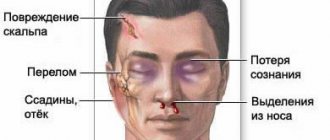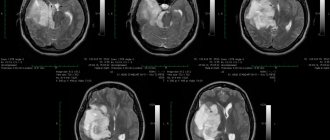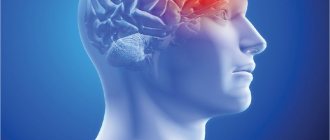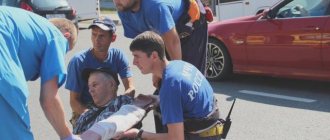Brain contusion is a traumatic brain injury and is accompanied by focal damage to brain tissue and necrosis. The consequences of this condition seriously affect the entire body. The patient may suffer from functional and neurological disorders, and there is also a risk of falling into a vegetative state.
A brain contusion can occur when falling from a great height, due to a strong blow, or during an accident. The condition also varies in severity of consequences.
Mild brain contusions
They are not accompanied by a threat to life and manifest themselves with the following symptoms:
- loss of consciousness, lethargy, drowsiness, memory loss;
- dizziness, vomiting;
- changes in heart function, increased blood pressure;
- neurological disorders (tremor of the eyeballs, lack of pupillary response to light, decreased muscle tone, anisocoria);
- meningeal symptoms (neck muscle tension, Brudzinski and Kernig symptoms).
There are no serious consequences for mild brain contusions. The prognosis for the patient is favorable. Symptoms disappear within 3 weeks.
Main services of Dr. Zavalishin’s clinic:
- consultation with a neurosurgeon
- treatment of spinal hernia
- brain surgery
- spine surgery
Complications of concussion
Among the consequences of a concussion there are numerous and varied complications. Thus, repeated (repeated) concussions cause a condition called dementia pugilistica, or boxer encephalopathy; This is a form of parkinsonism of a post-traumatic nature, characteristic of people who are professional boxers and periodically experience head injuries. The works of G. Martland, who described this syndrome, indicate characteristic signs of post-traumatic encephalopathy: a slight lag in the movements of one leg or “slaps” of the foot in the early stages, sometimes problems with maintaining balance, staggering; Some patients have a clearly noticeable slowness of action and periodic confusion. Sometimes the manifestations of the disease remain mild; in other cases, dragging of the legs, retardation of movements, specific mental disorders (for example, a decrease in the vocabulary used), trembling of the head and limbs are clearly observed.
Complications resulting from a head injury can be the most severe, so to the question of what to do in case of a concussion, the answer is clear: consult a doctor; after all, a traumatic brain injury of any type and severity can lead to changes in the mental component of the personality and/or physical disorders. Such complications include:
- The occurrence of a specific reaction to drinking alcohol or infection of the body: in a drunken state, with the flu or other infectious disease, the patient experiences confusion (delirium), outbursts of overexcitation and other mental disorders.
- Vasomotor type disorders associated with changes in vascular tone. They usually appear:
- persistent, persistent headaches, the intensity of which sharply increases with physical exertion on the body or simply sudden movements;
- dizziness that occurs during physical effort and tilting the body;
- alternating rushes of blood to the head area and subsequent severe pallor with increased sweating (often such manifestations are asymmetrical and involve one half of the head);
- rapid onset of general fatigue, lack of concentration.
- Uncontrollable outbursts of emotions, increased irritability, a person’s tendency to get excited quickly, easily fly into rage, often with aggression towards others. Quite often, aggressive outbursts are followed by a period of repentance, and the patient sincerely apologizes for his behavior.
- The manifestation of concussion symptoms in the form of seizures, similar to epileptic seizures.
- Acquisition of paranoid qualities by the patient’s personality, as well as neurotic states, when a person is overly nervous about any reason, anxious, and fearful. Patients lose the ability to concentrate, complain of headaches, sleep disturbances; Vasomotor disturbances are present.
More rare complications include psychotic disorders (psychoses), when the patient hallucinates, delusions, and has poor perception of reality. In some cases, mental disorders can lead to dementia - acquired dementia, characterized by serious shifts in thinking, memory, loss of a critical attitude and the ability to navigate the real environment, and apathetic states.
More often than others, according to experts, such consequences of a concussion as a specific post-concussion syndrome occur (the name is derived from the Latin words post - “after” and commotio - “shaking”). It can manifest itself a month or a year after the injury in the form of sharp, difficult-to-bear headaches, attacks of dizziness, restlessness and sleep disturbances, and problems concentrating on any usual activity. Psychotherapeutic treatment of concussion (more precisely, its consequences) in this case is rarely effective; Symptomatic treatment is recommended, but it should be remembered that taking strong painkillers can be more dangerous than the disease itself and cause the development of drug dependence.
Moderate brain contusions
This injury usually involves a fracture of the skull bones and is accompanied by subarachnoid hemorrhage. She shows herself:
- loss of consciousness for 1–3 hours, psychomotor agitation;
- amnesia;
- severe dizziness;
- nausea;
- vomiting;
- intense headaches;
- high blood pressure, rapid heartbeat;
- increased body temperature;
- meningeal symptoms;
- severe focal neurological symptoms (changes in muscle tone, paresis, loss of sensation in the limbs, epileptic seizures, speech impairment, etc.).
Signs of moderate brain contusions persist from several weeks to 2 months. The consequence of this condition may be irreversible changes that occurred during the injury.
Types of stroke
There are two types of cerebral stroke, depending on what pathological changes have occurred in the vessels. If the blood flow is blocked by an atherosclerotic plaque, or for other reasons, necrosis of brain cells occurs. This type of stroke is called ischemic. It may also be called a cerebral infarction. The prognosis for patients in this case is most often optimistic, doctors restore blood circulation and many complications can be avoided. The main thing is that the patient enters the hospital within the first 40 minutes after the attack. The most common cause of ischemic stroke is atherosclerosis.
Hemorrhagic stroke of the brainstem is much more dangerous. It occurs when a blood vessel bursts and bleeding into the brain begins. In this case, a hematoma is formed, which compresses the nerve endings and interferes with the normal functioning of the systems. Swelling and hypertension of the brain can often be fatal. Hemorrhage in the brain stem can occur with any cardiovascular disease.
Severe brain contusions
Such an injury poses a threat to human life. The consequences of a severe brain injury are serious, and recovery takes several months. Often the victim never fully recovers.
The following signs indicate a severe brain injury:
- loss of consciousness, after which the person is in stupor or a state of stupor;
- temperature rise to 41°C;
- psychomotor agitation, convulsive syndrome;
- disturbances in the respiratory and circulatory system (up to the need for artificial ventilation);
- neurological symptoms (dilation or constriction of pupils, “floating” eyeballs, difficulty swallowing, paralysis, loss of speech);
- pronounced meningeal signs.
Severe brain effects regress extremely slowly. Recovery takes a long time. In some cases, the patient becomes disabled.
The most common consequences of brain contusions are:
- inflammation of the meninges;
- epilepsy;
- atrophy (decrease in tissue volume) of the brain;
- hydrocephalus accompanied by intracranial hypertension;
- scars on the meninges and tissues;
- cerebrospinal fluid cysts;
- post-traumatic porencephaly;
- liquorrhea (due to a skull fracture).
These conditions are accompanied by movement disorders, dizziness, impaired coordination, speech, mental disorders, headaches, decreased intelligence, and convulsive seizures.
Brainstem stroke
Conservative therapy
Acute disorders of cerebral circulation of the brainstem zone require urgent hospitalization in a specialized vascular center or neurological hospital - optimally in the first 3 hours from the moment of onset.
The basis of therapy is conservative measures, which begin at the prehospital stage with the provision of emergency care, oxygenation, symptomatic correction (hypotensive, anticonvulsant). Early treatment helps improve the prognosis even with severe lesions. Restoration of vital functions, including mechanical ventilation, is carried out in the intensive care unit, where, after determining the characteristics of the brainstem stroke, specific treatment begins. It is aimed at restoring blood flow through the vessels of the vertebrobasilar bed, preventing complications and eliminating them, minimizing the risk of relapse, and normalizing basic physiological and biochemical constants. The key areas of drug therapy are:
- Intravenous thrombolysis.
The administration of thrombolytic agents (recombinant plasminogen activator) is indicated in the most acute period of the ischemic process. Despite the high efficiency of recanalization of arterial stenoses, such treatment has many contraindications and increases the risk of hemorrhagic complications. - Anticoagulants and antiplatelet agents.
The progressive course of brainstem stroke requires the use of anticoagulants - first low-molecular-weight heparins, then oral agents. They are also prescribed for preventive purposes after stabilization of cerebral hemorrhages. In all cases of acute brain stem ischemia, antiplatelet agents (acetylsalicylic acid) are required. - Neuroprotectors.
To improve cerebral perfusion, increase the regenerative potential of the affected nervous tissue, and accelerate the recovery of impaired functions, neuroprotectors are used. These include vasoactive (vinpocetine, pentoxifylline), neurotrophic agents (a complex of cerebral peptides or animal blood hemoderivat), antioxidants (thioctic acid, ascorbic acid, inosine).
Neurorehabilitation
Early comprehensive rehabilitation is of utmost importance for eliminating the consequences of brainstem stroke and restoring the functional capabilities of patients. The medical direction is based on ongoing neuroprotective therapy, spasticity and contractures are treated with muscle relaxants, and concomitant emotional and mental disorders are corrected with antidepressants.
Neurorehabilitation involves the use of kinesiotherapy, exercise therapy, and massage. Modern hardware technologies are being introduced into everyday practice in the form of robotic simulators operating using a biofeedback mechanism. Cyclic exercises allow you to activate the patient, restore movement, coordination and walking function. The possibilities for comprehensive rehabilitation are expanded by physical procedures, psychotherapy, social and labor adaptation.
Surgery
Radical correction of brainstem ischemic stroke involves the use of intravascular recanalization methods. Taking into account the clinical situation, selective intra-arterial thrombolysis, mechanical or aspiration thrombectomy, balloon angioplasty with stenting of extracranial vessels can be used. After intracranial hemorrhage with dislocation of brain structures, the hematoma is removed and decompressed through hemicraniectomy. Ventricular drainage surgery helps eliminate acute hydrocephalus.
Experimental treatment
Given the low level of evidence for existing drugs for neuroprotection, a search for new drugs is being conducted. The possibilities of antagonists of glutamate and NMDA receptors (eliprodil, selfotel), cytoprotective agents (lubeluzole), antioxidants (tirilazide) are being studied. Methods of stereotactic and endoscopic removal of hematomas require further study; ventricular thrombolysis and local hemostasis with recombinant factor VIIa are at the testing stage.
Painful stimulus
The patients of the department are primarily young people who have suffered neurotrauma as a result of a car accident. Van der Naalt: »The majority are men between 20 and 30 years old. Most often these are accidents related to driving a car, and 1/3 are under the influence of alcohol.' 5-10% are severe brain injuries, and the vast majority of patients are cases of mild and moderate neurotrauma. To determine the severity of brain damage, all patients undergo a series of tests upon admission. “When hospitalized, we use the Glasgow Coma Scale (GCS).” GCS is used to measure the severity of brain damage and to determine the possible degree of impairment of consciousness. This simple but reliable instrument measures the patient's spontaneous response after being addressed or when a painful stimulus is used. If the patient opens his eyes, we check the motor response of the hands and the presence of a verbal response. Patients also undergo a computed tomography (CT) scan. But not only deviations in CT indicate possible residual symptoms. For example, the final consequences of traumatic brain injury are indicated by the duration of post-traumatic amnesia (PTA), i.e. memory loss after an accident. »The duration of PTA is measured using standard questions. In addition, during the period from 1 to
3 months after a traumatic brain injury, we perform an MRI scan (magnetic resonance imaging) for patients whose complaints persist. MRI measures possible brain damage."
Consequences
A brain stem stroke is dangerous not only due to death, but also to a large percentage of patients’ disability. Often people who have had an attack cannot walk or even sit on their own. Their speech is impaired and they become completely dependent on the people caring for them. In addition, patients may experience a second attack at any time or develop dangerous complications. With this course of the disease, patients most often die.
The most common cause of death after a stroke is swelling of the brain stem. The resulting hematoma infringes on the trunk, and as a result, cardiac or respiratory arrest occurs. This complication develops in the first days after the attack.
In a later period, the patient may develop complications such as:
- Pneumonia.
- Vein blockage.
- Infectious diseases of the kidneys and urinary tract.
- Internal bleeding.
- Heart attack.
These are only those complications that can lead to the death of the patient, but there are others that significantly complicate patient care and bring the patient a lot of suffering, among them:
- Bedsores.
- Difficulty swallowing.
- Psycho-emotional disorders.
Those patients who can ambulate a little are often injured as a result of falls. Caring for post-stroke patients requires special patience from relatives. Treatment can last for years and often does not bring the desired results.
Recovery forecasts
Doctors' forecasts directly depend on what symptoms the patient has. The most favorable prognosis is for those patients whose symptoms are not pronounced, motor activity is preserved and speech is not impaired.
Poor prognosis. Doctors are hesitant to allow patients to fully recover if they experience the following symptoms:
- Speech impairment.
- Breathing problems.
- Low blood pressure.
- Fluctuations in body temperature.
Uncertain forecast:
- Swallowing dysfunction.
- Paralysis of limbs.
- Dizziness.
- Eye movement disorder.
It is worth noting that the prognosis for the patient also depends on his age and physical condition. The younger the patient, and the fewer concomitant diseases he has, the greater the chance of recovery. Also of particular importance for the subsequent condition of a patient who has suffered a cerebral infarction is the speed of hospitalization. The sooner a person is taken to the hospital, the greater the chance doctors have to prevent extensive pathological changes in the stem cells.
Cognitive problems
In most cases, patients have truly mild or moderate brain damage. After an accident, cognitive problems such as memory and concentration problems are noted. The effects of these mild forms of brain damage can affect work, family and social life. Over time, problems such as personality changes, increased irritability and decreased social behavior may also appear. “It is not uncommon for patients to show a good recovery at first glance, but over time they develop difficulties at work and in home situations,” explains Van der Naalt. At the same time, the majority of these patients resume their work activities within two months after the injury. Ultimately, 80% of them return to their old working level within six months, the rest have to change their type of activity or reduce the number of working hours. They still have residual symptoms, including fatigue, headaches, and problems with memory and concentration. Van der Naalt: “To return to the old level of functioning, they need to put in significantly more effort. Another problem they may face later is the inability to do several things at once. It's stressful."









